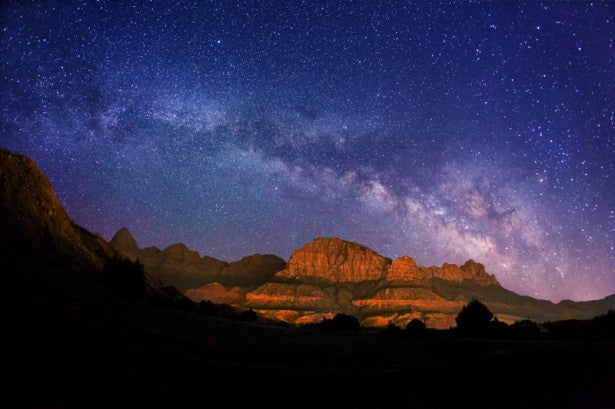Royce Bair has been a professional illustrative photographer since 1973 and an international lecturer on photography since 1982. His work has appeared in National Geographic, The Smithsonian, and on the covers of numerous books. As a photographer, writer, and entrepreneur, he has built and sold five photo-related businesses. He and his wife, Linda, are now shooting stock photography while they continue to share their knowledge and experience through workshops and blogs.
An intervalometer is a remote, electronic cable, or shutter release with a programmable timer. It is "remote" because the length of the cord prevents you from disturbing or jarring the the camera when you push its shutter release button and because you, or an assistant, do not have to be there to press that release button if it is properly programmed.
ROYCE'S EQUIPMENT
I used a Canon EOS 5D Mark II with a 15mm f/2.8 Fisheye lens @ f/2.8, with a 30-second exposure, ISO 6400. The photo was taken at midnight. The orange glow to the left of the Milky Way is light pollution from the town of Jackson, WY, about 20 miles away. The orange glow in the notch of the Teton Range is from the Idaho Falls metro area, about 75 miles away.)
HOW HE DID IT
In the above photo of the Milky Way over the Teton Range, I programmed my Canon intervalometer to give me a 3-minute head start (called a "delay") so that I had time to walk 800 feet to the right (about 300 feet past the view of the camera). It then remotely opened the shutter for a 30-second exposure, during which time I paint the foreground with a 2-million candlepower spotlight. The remote waited 30 seconds for me regroup myself (called an "interval") and then it opened the shutter again for another 30-second exposure. I had programmed it to do this five times so that I had a chance to get the light painting just right in at least one of those shots! That's because I had to light the trees and bushes on the left side much longer than the trees on the right side (closest to me) in order to give all the foliage an even exposure. During all of this, I kept an eye on my iPhone stopwatch display, which had been started at the same time as the intervalometer.
TIME LAPSE and STAR TRAILS
Intervalometers can also be used to do time lapse photography where you program the length of each exposure, the interval, or time between each exposure and the number of exposures you want to make. Software like QuickTime will chain these exposures together into a video. Similarly, these remotes can be used to produce star trails where the exposures are "stacked" together, thus reducing the need for one long exposure where noise build-up would degrade the final image.
INTERVALOMETERS
The remote release that I use with my Canon cameras is the Canon Timer Remote Controller TC-80N3. For Nikons, you may need to purchase the Nikon MC-36 Multifunction Remote Cord. Please note that many of the newer Nikon cameras, like the Nikon D600 and D800, have built in intervalometers. You may, however, still want to purchase the remote cord simply as an electronic "cable" or shutter release to prevent camera jarring or vibrations on longer exposures.
To learn more about Royce and night photography in general, be sure to check out his new Into the Night Photography blog.



2 comments
Arbica Mriea
This article is incredibly insightful! It offers valuable tips and techniques for capturing stunning night photography shots using an intervalometer. Thank you for sharing such helpful information and empowering photographers to enhance their skills in capturing captivating nighttime scenes. Feel free to explore the wedding services available at https://weddingworkflows.com!
Dr pankaj rai